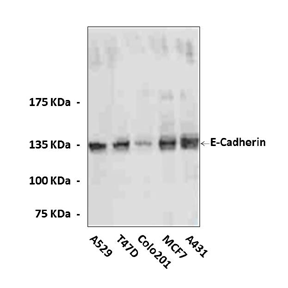Product Sheet CC1043
Description
BACKGROUND Cell adhesion molecules (CAMs) are cell surface proteins that are involved in cell-cell and cell-matrix interactions during embryonic development and in the maintenance of the tissue architecture of mature organisms. CAMs can be broadly grouped into four distinct families based on their structure and sequence homologies: integrins, the immunoglobulin-gene family, selectins and cadherins. Cadherins are calcium-dependent transmembrane glycoproteins that mediate cell-cell adhesion. The classic cadherin subfamily includes N-, P-, R-, B- and E-cadherins as well as about ten other members which are found in adherens junctions (AJ).1 These proteins share a common basic structure. The extracellular portions of the proteins are largely composed of repeating domains, each with two concensus Ca2+ binding motifs. The intracellular domain, the most conserved region of these molecules, is associated with cytoskeletal elements via cytoplasmic proteins termed catenins alpha, beta, and gamma) and plays a central role in cadherin function.2 Cadherins are the most important cell-cell receptors for the formation of physical cell-cell association and maintenance of normal tissue morphology.
E-cadherin is identical or homologous with uvomorulin, L-CAM, Arc-1, rr-1 and cell-CAM 120/80. E-cadherin is expressed throughout the epidermis except in the cornified layer and identified as one of adhesion molecules mediating keratinocyte -keratinocyte interaction. Inhibition of its function by specific antibodies causes strong perturbation of normal skin structure and grossly abnormal stratification.3 Several studies have shown that malignant epithelial carcinomas have decreased or no expression of E- and P cadherins.4 and it has been postulated that the resultant decrease in intercellular adhesiveness of these cancer cells might facilitate their invasion of surrounding tissues and metastasis to distant organs.
REFERENCES
1. Leckband D & Prakasam A: Ann. Rev. Biomed. Engin. 8: 259-287, 2006.
2. Alattia JR et al.: Cell. Mol. Life Sci. 55: 359-367, 1999.
3. Hirai Y et al.: Development 105:271-277, 1989.
4. Jeanes A et al.: Oncogene 27:6920–6929, 2008.
2. Alattia JR et al.: Cell. Mol. Life Sci. 55: 359-367, 1999.
3. Hirai Y et al.: Development 105:271-277, 1989.
4. Jeanes A et al.: Oncogene 27:6920–6929, 2008.
Products are for research use only. They are not intended for human, animal, or diagnostic applications.
Details
Cat.No.: | CC1043 |
Antigen: | Sequence near the human E-Cadherin carboxyl terminal. |
Isotype: | Affinity purified rabbit IgG |
Species & predicted species cross- reactivity ( ): | Human, Mouse, Rat |
Applications & Suggested starting dilutions: | WB 1:1000 IP n/d IHC (Paraffin) n/d ICC n/d FACS n/d |
Predicted Molecular Weight of protein: | 135 kDa |
Specificity/Sensitivity: | Detects endogenous levels of E-Cadherin proteins in various cell lysates. |
Storage: | Store at 4° C for frequent use; at -20° C for at least one year. |
*Optimal working dilutions must be determined by end user.
Products
| Product | Size | CAT.# | Price | Quantity |
|---|---|---|---|---|
| Polyclonal E-Cadherin Antibody: Polyclonal E-Cadherin Antibody | Size: 100 ul | CAT.#: CC1043 | Price: $302.00 |

